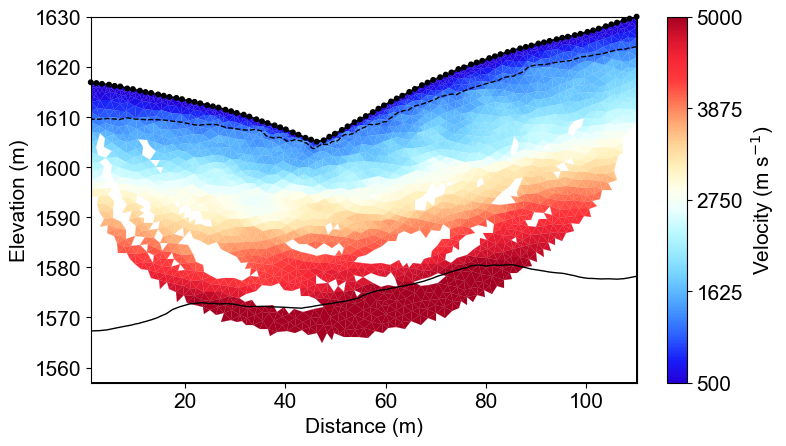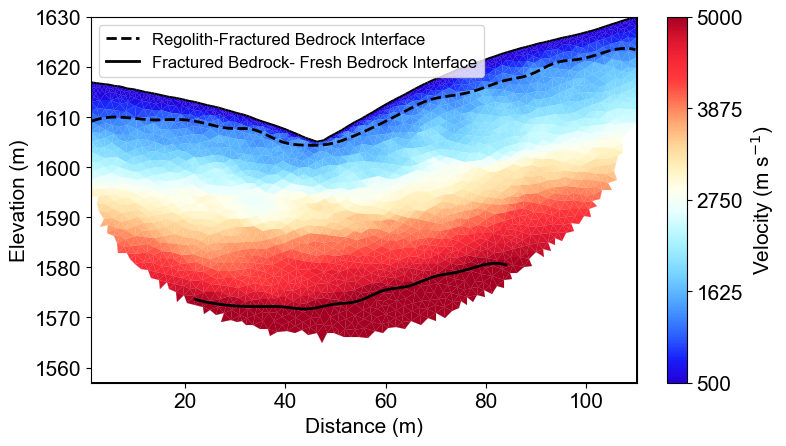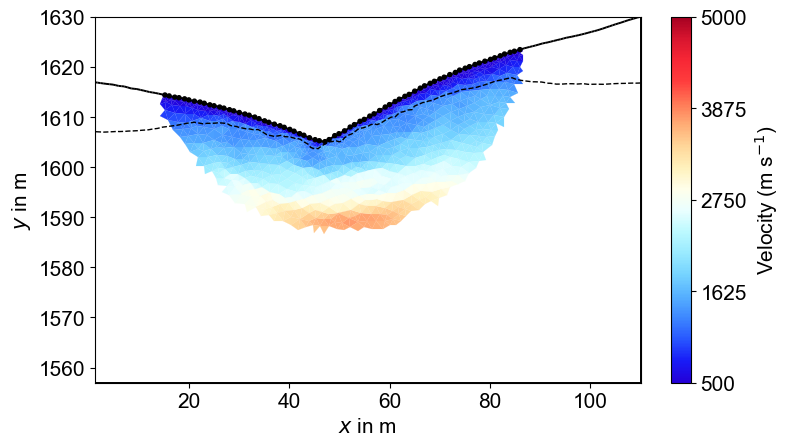Note
Go to the end to download the full example code
Ex. Seismic Refraction Tomography (SRT) Inversion and Interface Delineation
This example demonstrates how to perform a 2D seismic refraction tomography (SRT) inversion and interpret the results to define subsurface structures.
The script focuses on the inversion and post-processing stages of a geophysical workflow. It begins by loading pre-existing synthetic travel time data and then uses tomographic inversion to reconstruct the subsurface P-wave velocity distribution. A key feature demonstrated is the extraction of geological interfaces based on velocity thresholds.
The workflow includes: Loading Synthetic Data: The script loads pre-generated synthetic seismic travel time data for both a long and a short survey profile. Tomographic Inversion: It creates an unstructured mesh and performs a travel time inversion to estimate the subsurface P-wave velocity model for each dataset. Visualization: The resulting velocity tomograms are plotted, showing the recovered subsurface structure. Interface Extraction: For the long profile, the script uses the extract_velocity_interface function to automatically delineate boundaries between different geological layers (e.g., regolith, fractured bedrock, and fresh bedrock) based on velocity thresholds. Exporting Results: The coordinates of the extracted interfaces are saved to text files, making them available for constraining other models, such as hydrogeological simulations.
import os
import sys
import numpy as np
import matplotlib.pyplot as plt
import pygimli as pg
from pygimli.physics import ert
from pygimli.physics import TravelTimeManager
import pygimli.physics.traveltime as tt
from mpl_toolkits.axes_grid1 import make_axes_locatable
import pygimli.meshtools as mt
# Setup package path for development
try:
# For regular Python scripts
current_dir = os.path.dirname(os.path.abspath(__file__))
except NameError:
# For Jupyter notebooks
current_dir = os.getcwd()
# Add the parent directory to Python path
parent_dir = os.path.dirname(current_dir)
if parent_dir not in sys.path:
sys.path.append(parent_dir)
# Import PyHydroGeophysX modules
from PyHydroGeophysX.model_output.modflow_output import MODFLOWWaterContent
from PyHydroGeophysX.core.interpolation import ProfileInterpolator, create_surface_lines
from PyHydroGeophysX.core.mesh_utils import MeshCreator,fill_holes_2d,createTriangles,extract_velocity_interface
from PyHydroGeophysX.petrophysics.velocity_models import HertzMindlinModel, DEMModel
output_dir = "results/seismic_example"
os.makedirs(output_dir, exist_ok=True)
## Long seismic profile
### Load seismic data and inversion
datasrt = tt.load("./results/SRT_forward/synthetic_seismic_data_long.dat")
TT = pg.physics.traveltime.TravelTimeManager()
mesh_inv = TT.createMesh(datasrt, paraMaxCellSize=2, quality=32, paraDepth = 60.0)
TT.invert(datasrt, mesh = mesh_inv,lam=50,
zWeight=0.2,vTop=500, vBottom=8000,
verbose=1, limits=[300., 10000.])
### Get parameters for plotting layers
Get coverage and cell positions
cov = TT.standardizedCoverage()
pos = np.array(mesh_inv.cellCenters())
# For layered model visualization
x, y, triangles, _, dataIndex = createTriangles(mesh_inv)
z = pg.meshtools.cellDataToNodeData(mesh_inv,TT.model.array())
params = {'legend.fontsize': 15,
#'figure.figsize': (15, 5),
'axes.labelsize': 15,
'axes.titlesize':16,
'xtick.labelsize':15,
'ytick.labelsize':15}
import matplotlib.pylab as pylab
pylab.rcParams.update(params)
plt.rcParams["font.family"] = "Arial"
from palettable.lightbartlein.diverging import BlueDarkRed18_18
fixed_cmap = BlueDarkRed18_18.mpl_colormap
fig = plt.figure(figsize=[8,9])
ax1 = fig.add_subplot(1,1,1)
pg.show(mesh_inv,TT.model.array(),cMap=fixed_cmap,coverage = cov,ax = ax1,label='Velocity (m s$^{-1}$)',
xlabel="Distance (m)", ylabel="Elevation (m)",pad=0.3,cMin =500, cMax=5000
,orientation="vertical")
ax1.set_xlabel("Distance (m)", fontsize=15)
ax1.set_ylabel("Elevation (m)", fontsize=15)
ax1.tricontour(x, y, triangles, z, levels=[1200], linewidths=1.0, colors='k', linestyles='dashed')
ax1.tricontour(x, y, triangles, z, levels=[5000], linewidths=1.0, colors='k', linestyles='-')
pg.viewer.mpl.drawSensors(ax1, datasrt.sensors(), diam=0.9,
facecolor='black', edgecolor='black')
fig.savefig(os.path.join(output_dir, 'seismic_velocity_long.tiff'), dpi=300, bbox_inches='tight')
Long Profile Seismic Velocity Model
The seismic tomography reveals three-layer velocity structure: weathered regolith (blue, <1200 m/s), fractured bedrock (green-yellow, 1200-5000 m/s), and fresh bedrock (red, >5000 m/s). Dashed and solid lines show extracted geological interfaces at 1200 and 5000 m/s respectively.

%% [markdown] ### Get subsurface structure for hydrologic modeling
Assuming TT.model.array() gives you the velocity values
velocity_data = TT.model.array()
# Call the function with velocity data
# Get subsurface structure (Regolith) for hydrologic modeling
smooth_x1, smooth_z1 = extract_velocity_interface(mesh_inv, velocity_data, threshold=1200,interval = 5)
# Get subsurface structure (Fractured bedrock) for hydrologic modeling
# Here we limit the x range to extract the structure area within the coverage as shown in the figure
smooth_x2, smooth_z2 = extract_velocity_interface(mesh_inv, velocity_data, threshold=5000,interval = 5, x_min=22, x_max=84)
# plot the extracted interfaces withe filled velocity images
filled_cov1 = fill_holes_2d(pos, TT.standardizedCoverage())
fig = plt.figure(figsize=[8,9])
ax1 = fig.add_subplot(1,1,1)
pg.show(mesh_inv,TT.model.array(),cMap=fixed_cmap,coverage = filled_cov1,ax = ax1,label='Velocity (m s$^{-1}$)',
xlabel="Distance (m)", ylabel="Elevation (m)",pad=0.3,cMin =500, cMax=5000
,orientation="vertical")
ax1.set_xlabel("Distance (m)", fontsize=15)
ax1.set_ylabel("Elevation (m)", fontsize=15)
ax1.plot(smooth_x1, smooth_z1, 'k--', linewidth=2, label='Regolith-Fractured Bedrock Interface')
ax1.plot(smooth_x2, smooth_z2, 'k-', linewidth=2, label='Fractured Bedrock- Fresh Bedrock Interface')
ax1.legend(fontsize=12)
np.savetxt(os.path.join(output_dir, 'regolith_interface.txt'), np.c_[smooth_x1, smooth_z1])
np.savetxt(os.path.join(output_dir, 'fractured_bedrock_interface.txt'), np.c_[smooth_x2, smooth_z2])
Automated Interface Extraction
Two critical geological boundaries extracted from velocity thresholds: regolith-bedrock interface (dashed line, 1200 m/s) and fractured-fresh bedrock interface (solid line, 5000 m/s). Interfaces are smoothed and exported as text files for integration with hydrogeological models.

%% [markdown] ## Short seismic profiles
ttData = tt.load("./results/workflow_example/synthetic_seismic_data.dat")
TT_short = pg.physics.traveltime.TravelTimeManager()
mesh_inv1 = TT_short.createMesh(ttData , paraMaxCellSize=2, quality=32, paraDepth = 30.0)
TT_short.invert(ttData , mesh = mesh_inv,lam=50,
zWeight=0.2,vTop=500, vBottom=5500,
verbose=1, limits=[300., 8000.])
x1, y1, triangles1, _, dataIndex1 = createTriangles(mesh_inv)
z1 = pg.meshtools.cellDataToNodeData(mesh_inv,np.array(TT_short.model))
pos = np.array(mesh_inv.cellCenters())
filled_cov1 = fill_holes_2d(pos, TT_short.standardizedCoverage())
params = {'legend.fontsize': 15,
#'figure.figsize': (15, 5),
'axes.labelsize': 15,
'axes.titlesize':16,
'xtick.labelsize':15,
'ytick.labelsize':15}
import matplotlib.pylab as pylab
pylab.rcParams.update(params)
plt.rcParams["font.family"] = "Arial"
from palettable.lightbartlein.diverging import BlueDarkRed18_18
fixed_cmap = BlueDarkRed18_18.mpl_colormap
fig = plt.figure(figsize=[8,9])
ax1 = fig.add_subplot(1,1,1)
pg.show(mesh_inv,TT_short.model.array(),cMap=fixed_cmap,coverage = TT_short.standardizedCoverage(),ax = ax1,label='Velocity (m s$^{-1}$)',
xlabel="Distance (m)", ylabel="Elevation (m)",pad=0.3,cMin =500, cMax=5000
,orientation="vertical")
ax1.set_xlabel("Distance (m)", fontsize=15)
ax1.set_ylabel("Elevation (m)", fontsize=15)
ax1.tricontour(x1, y1, triangles1, z1, levels=[1200], linewidths=1.0, colors='k', linestyles='dashed')
pg.viewer.mpl.drawSensors(ax1, ttData.sensors(), diam=0.8,
facecolor='black', edgecolor='black')
fig.savefig(os.path.join(output_dir, 'seismic_velocity_short.tiff'), dpi=300, bbox_inches='tight')
Short Profile Multi-Scale Comparison
Short profile provides enhanced shallow resolution (0-30m depth) with detailed regolith characterization. Higher ray density improves near-surface velocity mapping while sacrificing deeper penetration. The 1200 m/s interface shows excellent agreement with the long profile.

Summary
This example demonstrated seismic refraction tomography with automated interface extraction for watershed applications. Key results include three-layer velocity structure resolution, interface extraction at 1200 and 5000 m/s thresholds, and multi-scale survey comparison.
The extracted interfaces provide structural constraints for ERT inversions and direct input for hydrogeological models like MODFLOW and ParFlow.
Total running time of the script: (0 minutes 0.000 seconds)